Five Hosta Nurseries Share The Companion Plants They Use To Help Deter Pests

PERENNIALS > HOSTA > COMPANIONS
Reviewed By COLIN SKELLY

Colin is a Horticulturist and Horticultural Consultant with experience in a range of practical and managerial roles across heritage, commercial and public horticulture. He holds the Royal Horticultural Society’s Master of Horticulture award and has a particular interest in horticultural ecology and naturalistic planting for habitat and climate resilience.
Contributions From MELANIE COLLINS

Mickfield Hostas is home to the largest National Collection of British Hostas in the UK, according to Plant Heritage. Melanie is a Partner at this specialist plant nursery, which won 7 RHS gold medals at flower shows in 2016 alone. She has her own YouTube channel where she shares updates from the nursery.

Barry is the membership secretary from the American Hosta Society. He is a retired owner of a specialist hosta nursery based in Illinois with over 40 years of growing experience.

An RHS gold-medalist, recently winning two golds at the Chelsea Flower Show in 2021 and 2022, Ollie is the Nursery Manager at Sienna Hostas. Ollie is also a member of The British Hosta and Hemerocallis Society.

With 50 years of experience in the landscaping business, John has been growing and selling hostas for 15 years and is the owner of specialist nursery Rewela Hostas. Based in Yorkshire, he has his own YouTube channel where he shares plant care and growing tips.

Sue is the Owner of Sue Proctor Plants, a specialist Hosta nursery based in West Yorkshire. She has been growing Hostas for over 50 years and miniature varieties for over 20 years. She runs her nursery with her husband Richard.
IN THIS GUIDE
- 1) Scaly Male Fern
- 2) Lady’s Mantle
- 3) Common Dogwood
- 4) Garden Forget-Me-Not
- 5) Lesser Periwinkle
- 6) Leopard Plant
- 7) Siberian Bugloss
- 8) Common Grape Hyacinth
- 9) Chives
- 10) Large-Flowered Barrenwort
- 11) Spotted Deadnettle
- 12) Caladium
- 13) Bleeding Heart
- 14) Creeping Jenny
- 15) Monk’s Hood
- 16) Common Lungwort
- 17) Asarabacca
- 18) Coral Bells
- 19) Sweet Woodruff
- 20) Wild Daffodil
- 21) Foam Flower
- 22) Wood Anemone
- 23) Chinese Astilbe
- 24) Japanese Forest Grass
- 25) Common Snowdrop
- 26) Sikkim Spurge
- 27) Holly-Leaved Sweet Spire
- 28) Cohosh Bugbane
- 29) Siberian Squill
- 30) Painted Lady Fern
Hostas are commonly grown for their stunning foliage that comes in a range of colours from deep green to coppery-bronze.
These easy-to-grow plants grow best when sited in the shade, so you might be wondering which plants you can grow with hostas that will tolerate these conditions, whilst also looking great and complementing one another.
“With hostas, there is such a huge range of colours, textures and forms in the hosta world that you could just grow hostas and have a spectacular display,” says Melanie Collins from Mickfield Hostas.
“However, Astrantia, members of the Onion family (such as Alliums) and Wild Garlic help deter snails, so are very useful companions.

“Given the fact that hostas are generally shade-loving plants, there are so many companions for them, but the most effective are ferns and plants with different foliage types.
“Hostas are native to Japan, Korea and China, so they like dappled shade from small trees such as acers. However, remember to water more often if they are in close proximity to large trees and shrubs.”
“Since hostas die down in winter we under-plant with whatever will give winter and spring colour,” explains Sue Proctor, the owner of Sue Proctor Plants, a specialist Hosta nursery.
“From January until early April, our hosta beds display a succession of winter and spring flowering plants, from cyclamen, aconites and snowdrops to all kinds of spring bulbs.
“In mixed borders, heucheras and small evergreen shrubs such as euonymus, hebe and skimmia provide the same colourful service.
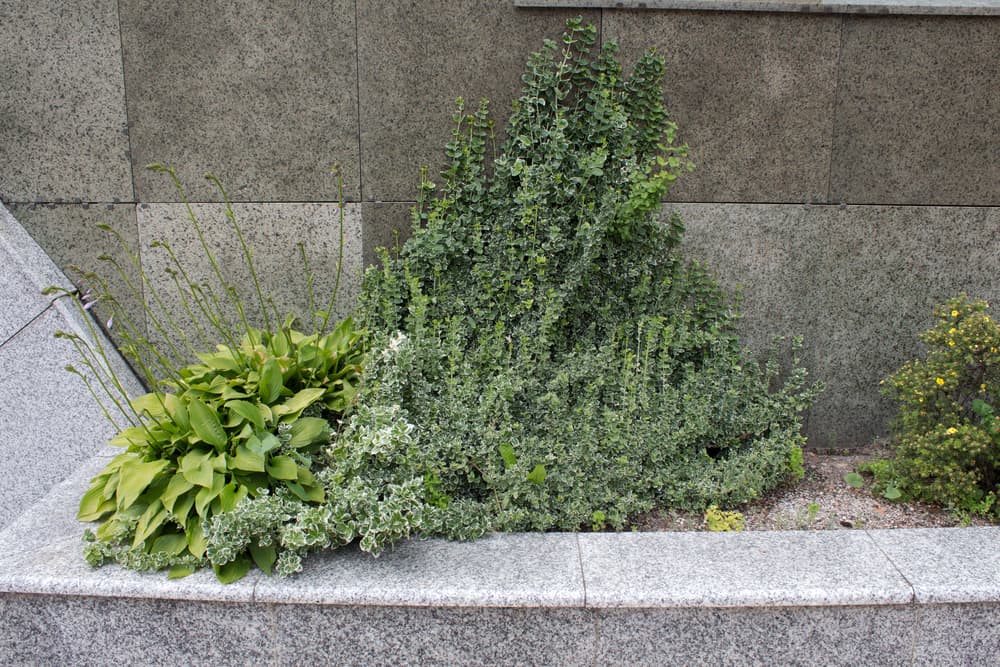
“For companion plants, we tend to choose those with different foliage to hostas.
“For over-arching shade, acers are ideal, with a good selection of smaller growing varieties that are less than 2m tall for containers or smaller gardens.
“In our partially shaded gravel garden, we plant hostas with ferns, as they enjoy similar conditions.”
In this guide, I share thirty(!) companion plants to grow that not only love the shade, but will bring their own unique benefits when planted amongst the visually brilliant foliage of one or more hostas.
1) Scaly Male Fern

- BOTANICAL NAME: Dryopteris affinis
- HARDINESS RATING: H5
- PLANT TYPE: fern
- SOIL PREFERENCE: all soil types; any pH
- SIZE: 1-1.5m in height, 0.5-1m spread
Starting with the ultimate shade-loving plant, the scaly male fern is an evergreen plant that produces lovely green foliage that is sometimes tinged with yellow – meaning it pairs well with hostas.
When we interviewed them, experts from Rewela Hostas, the American Hosta Society and Sienna Hostas all recommend growing hardy ferns with hosta plants.
Together, they will look great in a garden bed or border and can be left to their own devices, as ferns are not fussy plants once established.
2) Lady’s Mantle
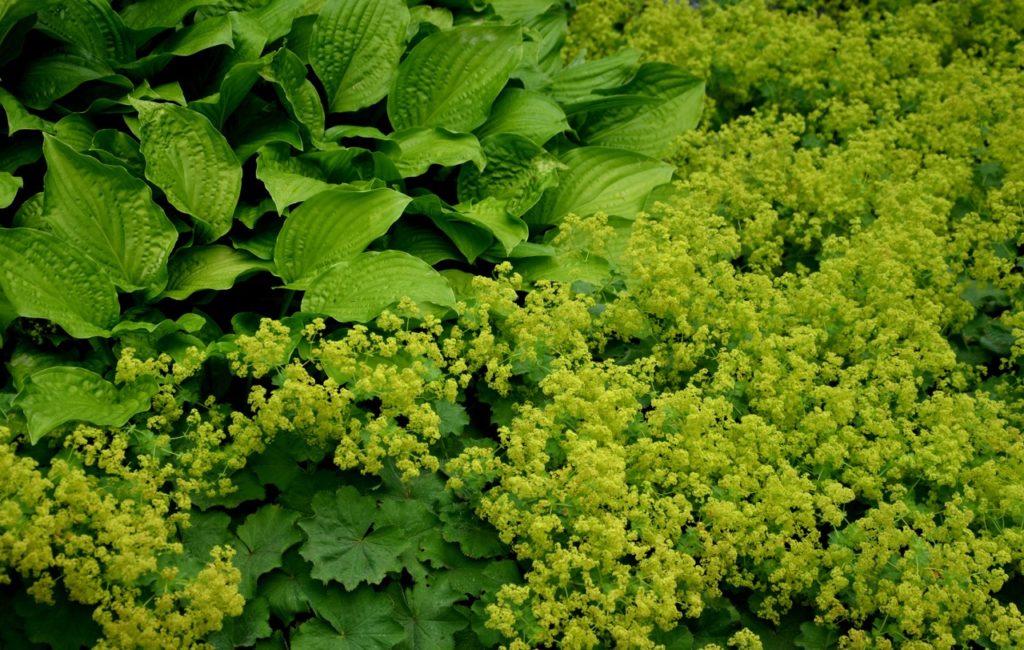
- BOTANICAL NAME: Alchemilla mollis
- HARDINESS RATING: H7
- PLANT TYPE: perennial
- FLOWERS: yellow
- FLOWERING SEASON(S): summer / autumn
- SOIL PREFERENCE: all soil types; any pH
- SIZE: 0.1-0.5m in height, 0.1-0.5m spread
Alchemilla mollis, also known as Lady’s Mantle, is a perennial with fuzzy leaves that are edged with small ridges and yellowy-green flowers that appear during the summer and autumn months.
This plant thrives in full shade but is also tolerant of some sunshine too, so makes a great companion plant for your hostas – wherever they are growing in your garden.
3) Common Dogwood
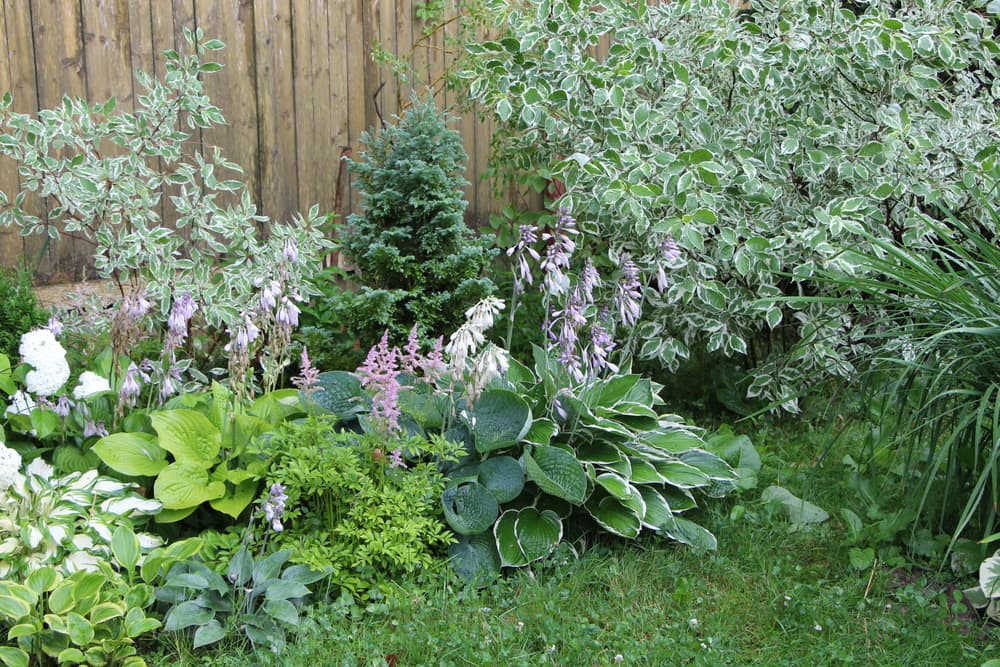
- BOTANICAL NAME: Cornus sanguinea
- HARDINESS RATING: H6
- PLANT TYPE: shrub
- FLOWERS: white
- FLOWERING SEASON(S): summer
- SOIL PREFERENCE: all soil types; any pH
- SIZE: 1.5-2.5m in height, 1.5-2.5m spread
This white-flowering shrub produces large oval-shaped leaves that turn a bright red in the autumn months, leaving behind red stems when the plant eventually dies back in the winter.
Cornus alba (the variety pictured above) also makes for an excellent complementary plant – as you can see, the foliage bears similar colours to that of many hosta varieties.
Common dogwood would make a colourful addition to any existing hosta display.
You could try underplanting your dogwood plant with hostas so they can enjoy and grow into the shade that this bushy shrub provides.
4) Garden Forget-Me-Not
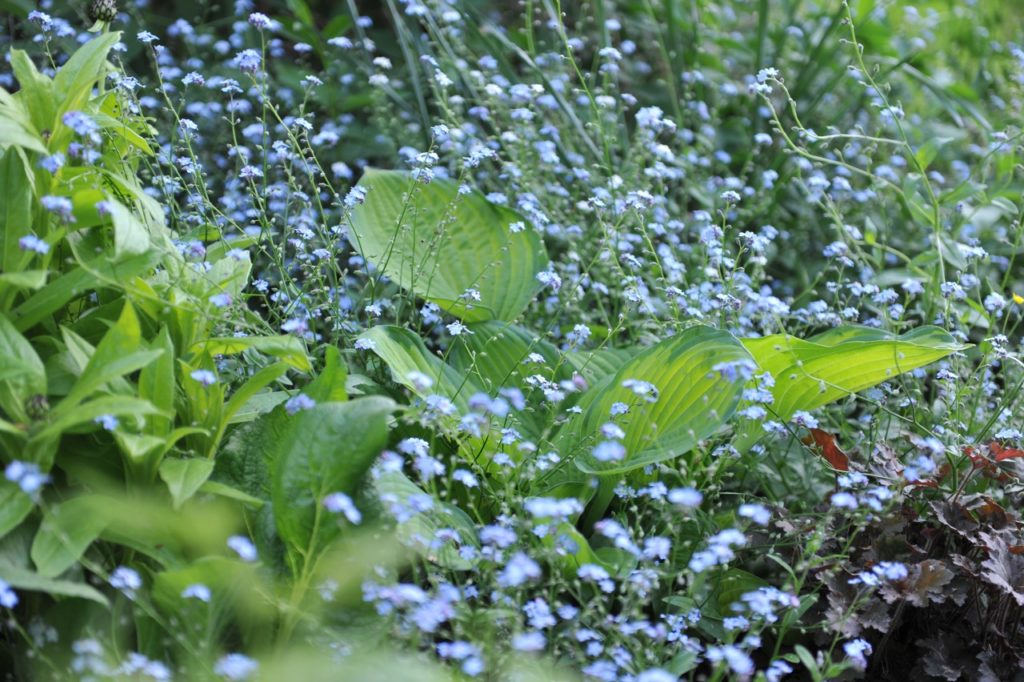
- BOTANICAL NAME: Myosotis sylvatica
- HARDINESS RATING: H6
- PLANT TYPE: perennial
- FLOWERS: blue
- FLOWERING SEASON(S): spring / summer
- SOIL PREFERENCE: chalk, clay, loam; any pH
- SIZE: 0.1-0.5m in height, 0.1-0.5m spread
Forget-me-nots are cottage garden favourites and are beloved by gardeners in the UK because of their low-maintenance nature once planted.
Thriving in partial shade, forget-me-nots prefer the same conditions as hosta plants and will add some complementary colour with their dainty blue flowers.
This deciduous perennial is also a great choice for pollinators, as bees and butterflies can enjoy their flowers throughout spring and summer.
5) Lesser Periwinkle
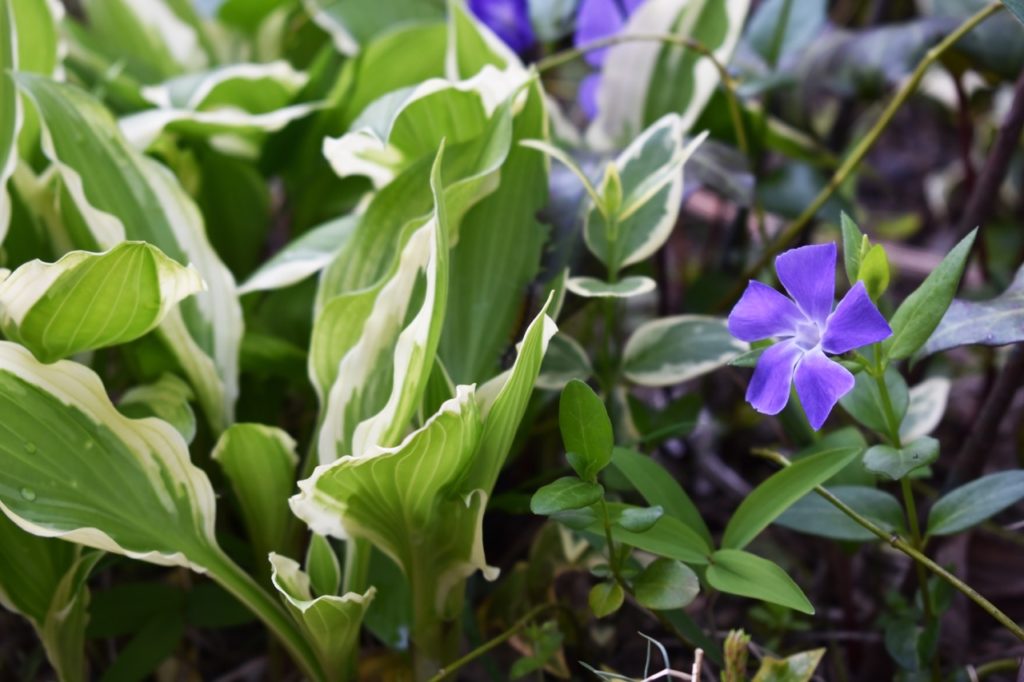
- BOTANICAL NAME: Vinca minor
- HARDINESS RATING: H6
- PLANT TYPE: perennial / sub-shrub
- FLOWERS: blue, purple or white
- FLOWERING SEASON(S): spring / summer / autumn
- SOIL PREFERENCE: all soil types; any pH
- SIZE: 0.1-0.5m in height, 1.5-2.5m spread
Commonly used for ground cover in garden beds, Vinca minor is another perennial that thrives in the sun, making it a great choice for planting next to hostas.
Lesser periwinkles typically bear violet flowers from spring through to autumn and produce glossy green leaves that remain on the plant throughout the year.
Their evergreen foliage will be great for adding interest to your perennial borders in the months that hostas go dormant.
They are slightly invasive (though not quite as vigorous as Vinca major) so you should only be prepared to introduce this plant if you’re prepared to keep it well-maintained.
6) Leopard Plant
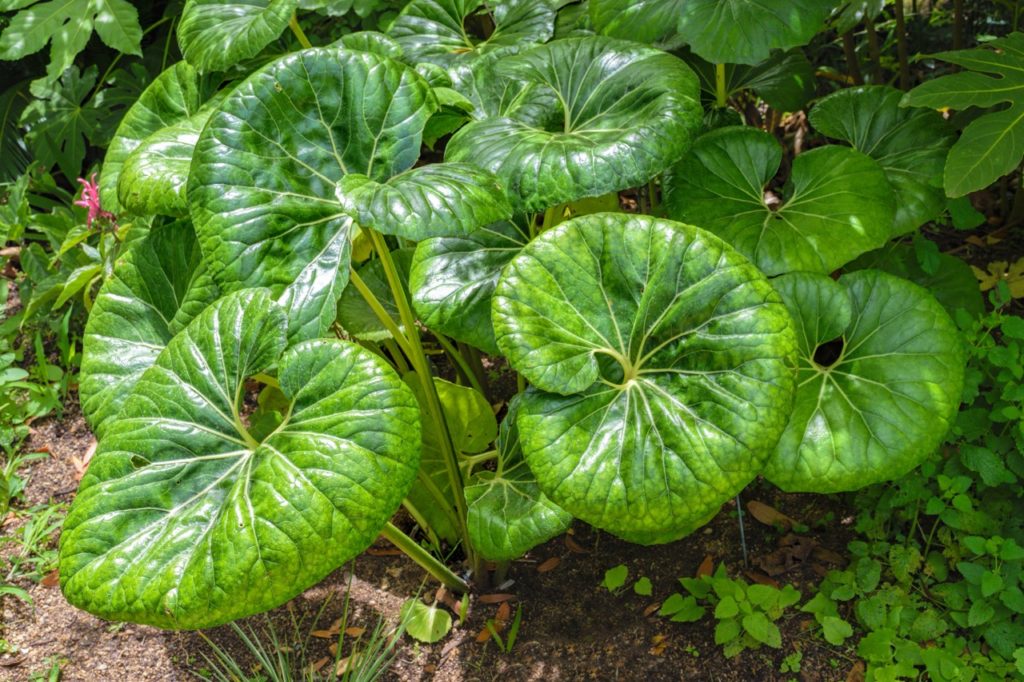
- BOTANICAL NAME: Farfugium japonicum
- HARDINESS RATING: H3
- PLANT TYPE: perennial
- FLOWERS: yellow
- FLOWERING SEASON(S): autumn / winter
- SOIL PREFERENCE: all soil types; any pH
- SIZE: 0.5-1m in height, 0.5-1m spread
Like hostas, the foliage of the Leopard Plant is its main attraction, with the plant producing large, kidney-shaped, green leaves that offer year-round interest.
However, this plant is only H3 hardy, meaning it will most likely need some element of frost-protection here in the UK during the colder months of the year.
I’d recommend planting Farfugium japonicum and your chosen hosta in a large container that can then be moved to a warmer location before the first frost hits – either indoors or in a heated greenhouse.
7) Siberian Bugloss
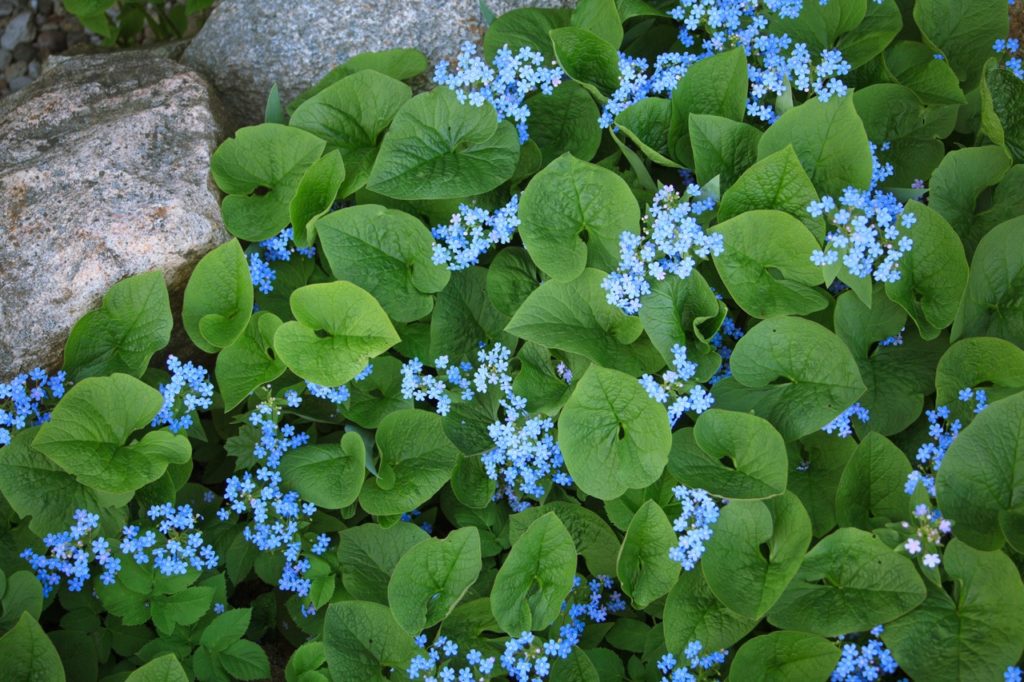
- BOTANICAL NAME: Brunnera macrophylla
- HARDINESS RATING: H6
- PLANT TYPE: perennial
- FLOWERS: blue
- FLOWERING SEASON(S): spring
- SOIL PREFERENCE: all soil types; any pH
- SIZE: 0.1-0.5m in height, 0.1-0.5m spread
Siberian Bugloss is a small shade-loving perennial that grows to only 50cm in height and spread and is another favourite of the growers at Sienna Hostas.
It bears beautiful blue flowers in the spring and heart-shaped leaves that die back over autumn and winter.
This low-maintenance perennial can thrive in garden beds or borders when planted with other plants that do best in the same conditions – like hostas.
8) Common Grape Hyacinth

- BOTANICAL NAME: Muscari neglectum
- HARDINESS RATING: H6
- PLANT TYPE: perennial / bulb
- FLOWERS: blue and black
- FLOWERING SEASON(S): spring
- SOIL PREFERENCE: all soil types; any pH
- SIZE: 0.1-0.5m in height, 0-0.1m spread
Commonly grown in wildflower meadows or cottage garden planting schemes, grape hyacinths are perennials that can be grown in partial shade and can provide a burst of blue colour in the spring when planted next to hostas.
These bulbs produce bell-shaped flowers that grow in clusters at the top of tall stems that reach up to 50cm tall.
9) Chives
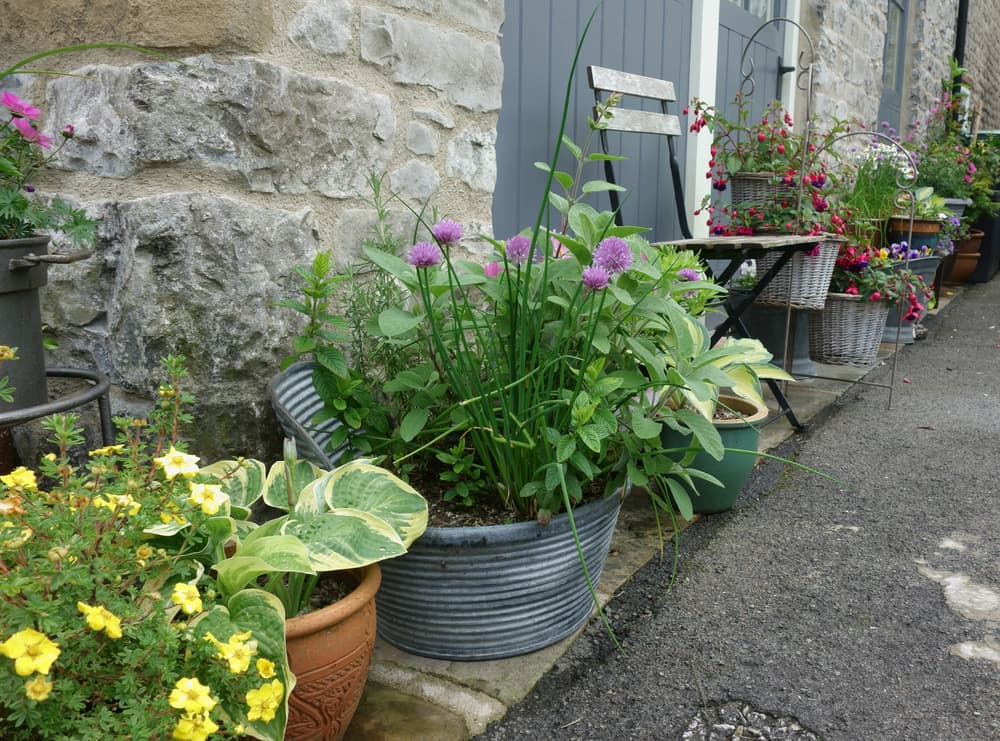
- BOTANICAL NAME: Allium schoenoprasum
- HARDINESS RATING: H6
- PLANT TYPE: bulb / perennial
- FLOWERS: purple
- FLOWERING SEASON(S): summer
- SOIL PREFERENCE: all soil types; any pH
- SIZE: 0.1-0.5m in height, 0-0.1m spread
Chives might be an ornamental perennial that you overlook when considering companion plants for your hostas, but I think that their distinctive purple blooms look great in more natural planting schemes.
Easy to grow, chives produce fragrant foliage that can be harvested in summer and used as a herb in many recipes.
You can even grow them in pots with paired plants as shown in the image above.
10) Large-Flowered Barrenwort
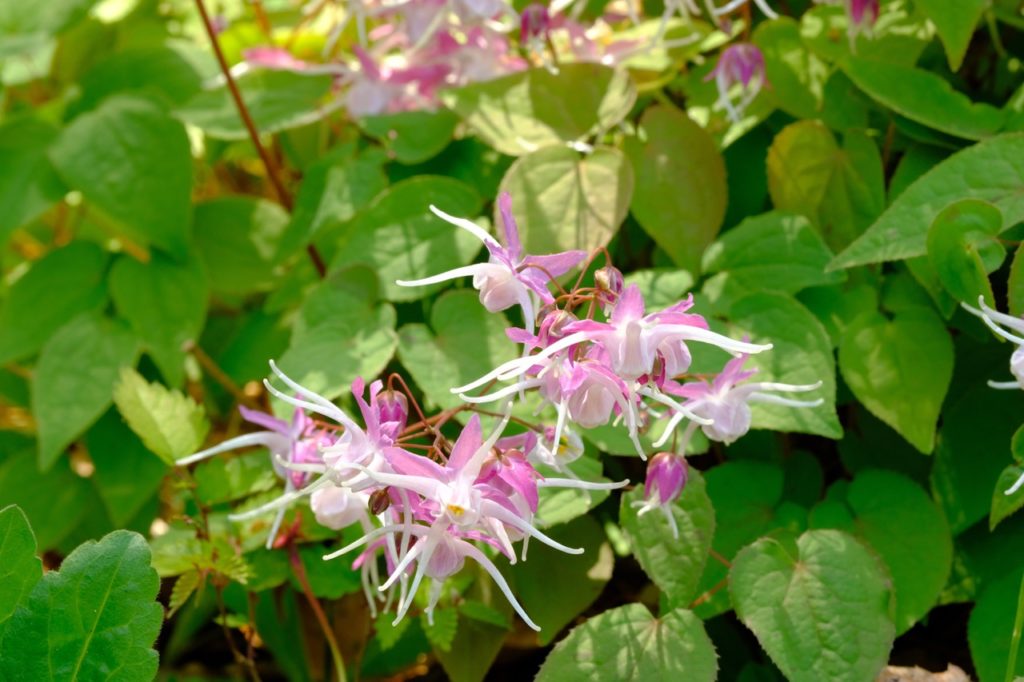
- BOTANICAL NAME: Epimedium grandiflorum
- HARDINESS RATING: H5
- PLANT TYPE: perennial
- FLOWERS: white, pink, yellow and purple
- FLOWERING SEASON(S): spring
- SOIL PREFERENCE: clay, loam, sand; acidic to neutral pH
- SIZE: 0.1-0.5m in height, 0.1-0.5m spread
With unusual flowers that come in open sprays of various colours, Epimedium grandiflorum, also referred to as large-flowered barrenwort, is another shade-loving perennial that will brighten up your hosta displays.
In addition to this plant’s floriferous interest, its large heart-shaped leaves are often tinged with a bronze hue in the spring.
“Hostas always pair well with Ferns, but we also like planting Epimediums with them too,” says Ollie Walker, the nursery manager from Sienna Hostas.
If you want to plant Barrenwort in your flower beds, make sure the growing medium has a slightly acidic pH, as this perennial will not cope in alkaline conditions.
11) Spotted Deadnettle
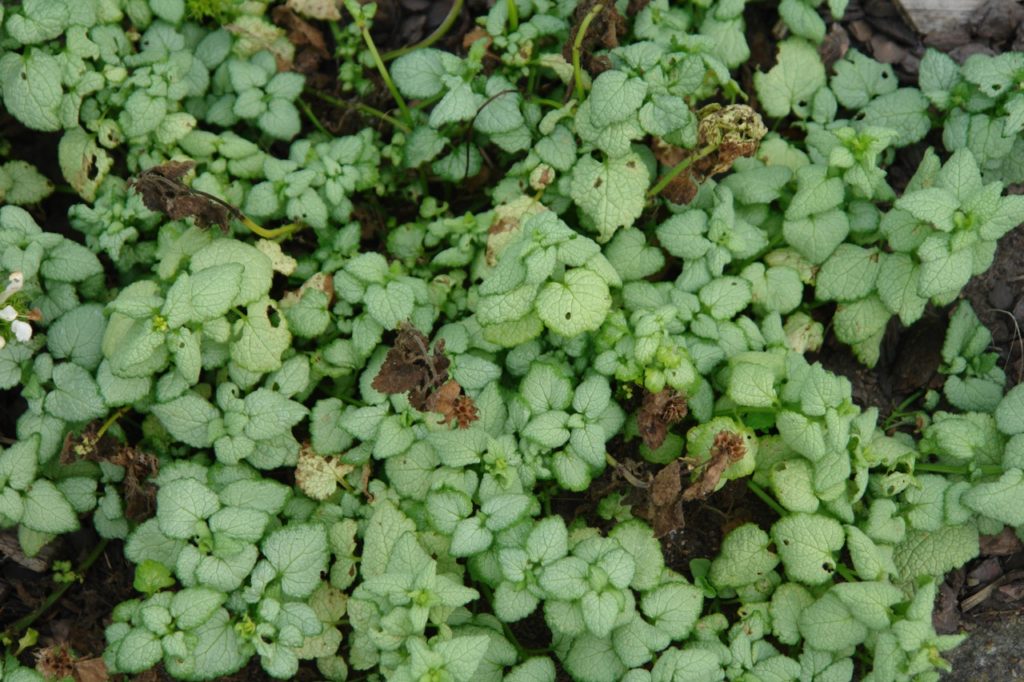
- BOTANICAL NAME: Lamium hirsutum
- HARDINESS RATING: H7
- PLANT TYPE: perennial
- FLOWERS: purple, white and pink
- FLOWERING SEASON(S): summer
- SOIL PREFERENCE: all soil types; any pH
- SIZE: 0.1-0.5m in height, 0.5-1m spread
The Spotted Deadnettle is a mat-forming perennial that makes a great ground cover and thrives in the shade.
Like hostas, its foliage is impressive and often variegated, but this plant does also produces colourful blooms that grow on tall stems in the summer months.
12) Caladium
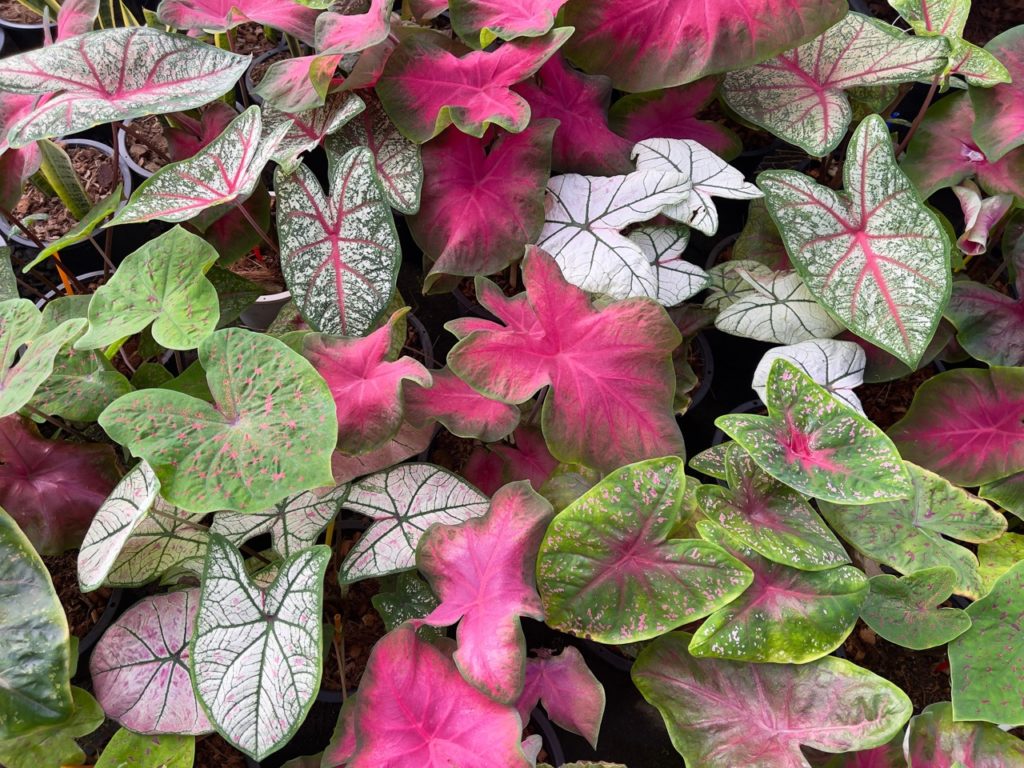
- BOTANICAL NAME: Caladium
- HARDINESS RATING: H1B
- PLANT TYPE: houseplant / perennial
- SOIL PREFERENCE: loam; any pH
- SIZE: 0.5-1m in height, 0.1-0.5m spread
One of my favourite plants for its beautiful foliage, caladium produces stunning leaves that are often variegated in shades of pink, white and green.
Caladiums need to be grown in loamy soil and cannot survive even mild temperatures outside, which is why they are grown as houseplants here in the UK.
So, if you are willing to try something different, you could plant this perennial in a large container with hostas and grow them together indoors out of direct sunlight.
13) Bleeding Heart
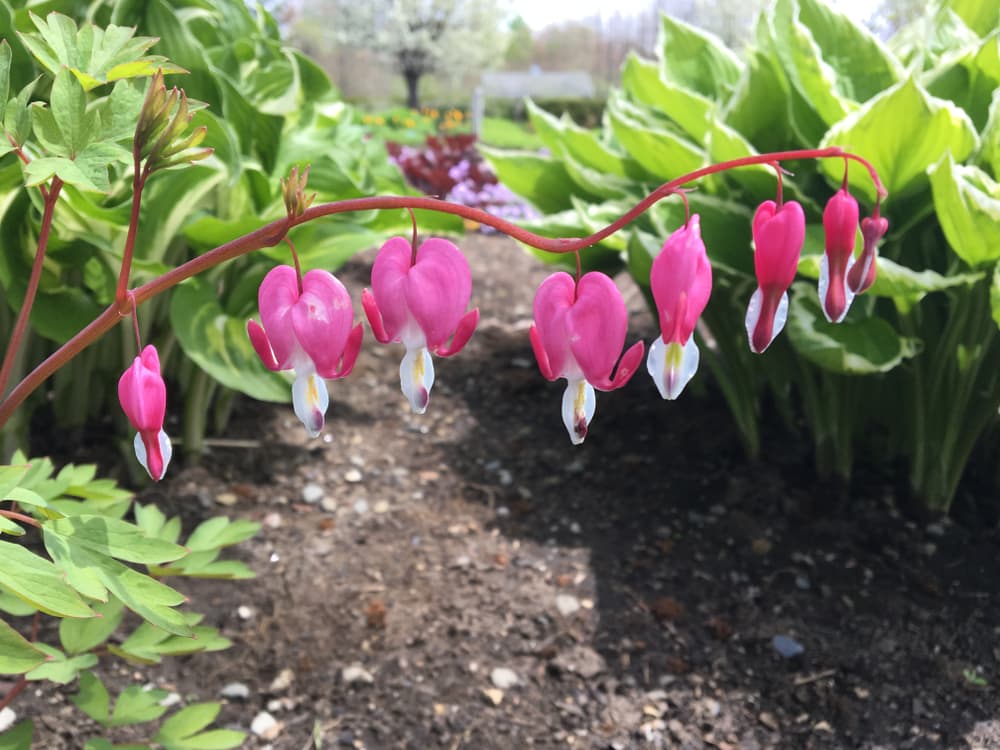
- BOTANICAL NAME: Lamprocapnos spectabilis
- HARDINESS RATING: H6
- PLANT TYPE: perennial
- FLOWERS: red and white
- FLOWERING SEASON(S): spring and summer
- SOIL PREFERENCE: chalk, clay, loam; alkaline to neutral pH
- SIZE: 0.5-1m in height, 0.5-1m spread
Lamprocapnos spectabilis, more commonly known as ‘Bleeding Hearts’, bear heart-shaped pink and white flowers from arching stems during the spring and summer months.
These flowers are one of a kind and, thankfully, are really easy to grow here in the UK, as long as they are planted in the right location.
This unique perennial needs to be grown in shade, making them suitable for hosta companion planting, and also requires alkaline soil for it to thrive.
14) Creeping Jenny
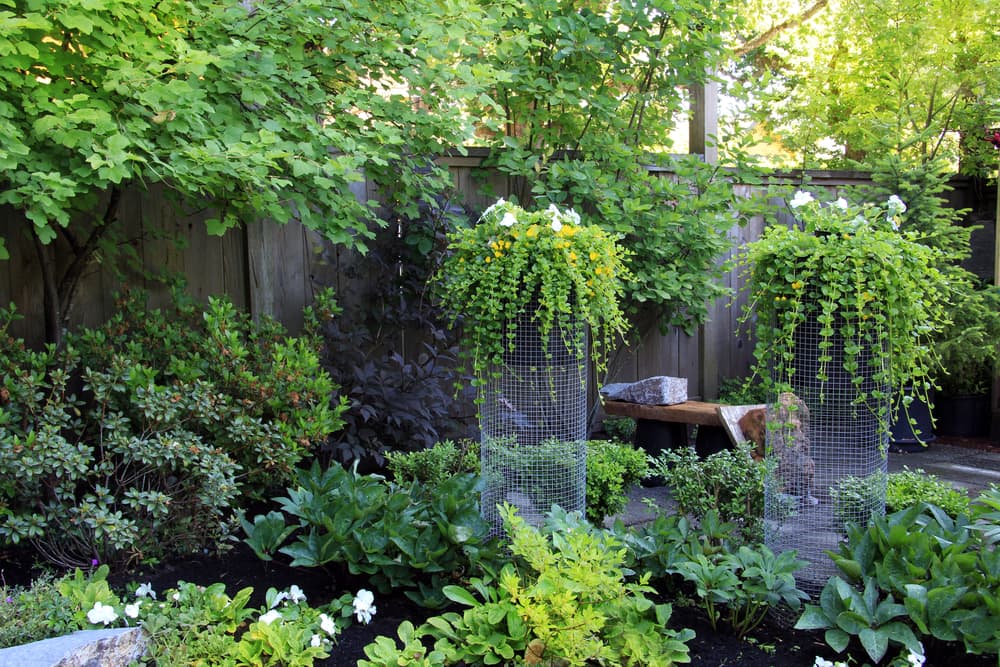
- BOTANICAL NAME: Lysimachia nummularia
- HARDINESS RATING: H6
- PLANT TYPE: perennial
- FLOWERS: yellow
- FLOWERING SEASON(S): summer
- SOIL PREFERENCE: clay or loam; any pH
- SIZE: 0.1-0.5m in height, 0.1-0.5m spread
With bright yellow flowers appearing in the summer, creeping Jenny is a great colourful addition to any garden display and will look lovely next to hostas.
These fully hardy perennials have heart-shaped glossy leaves that die back over winter and are often accented with black spots, making for an interesting contrast.
Creeping Jenny is easy to grow and care for and is a great choice for a wildlife-friendly garden.
15) Monk’s Hood
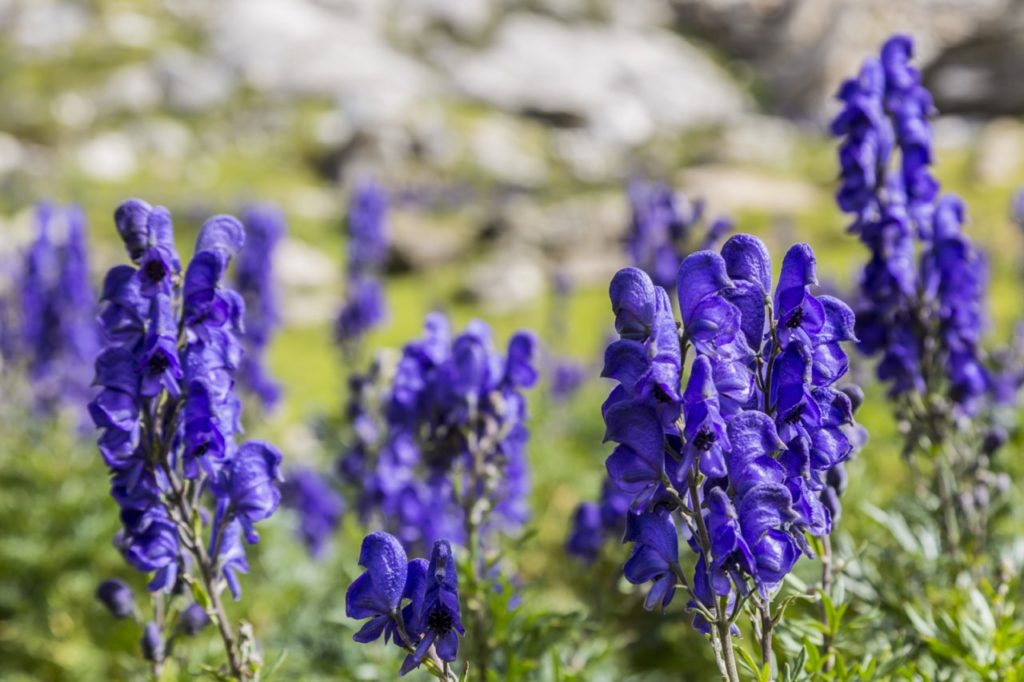
- BOTANICAL NAME: Aconitum napellus
- HARDINESS RATING: H7
- PLANT TYPE: perennial
- FLOWERS: blue
- FLOWERING SEASON(S): summer
- SOIL PREFERENCE: clay and loam; any pH
- SIZE: 1-1.5m in height, 0.1-0.5m spread
With blue hooded blooms that grow on erect stems up to 1.5m tall, Monk’s Hood is definitely a statement plant for your garden displays.
Growing best in partial shade, Aconitum napellus only flowers during the summer, but its bushy foliage makes a great shelter for the wildlife in your garden, even when the leaves die back in autumn.
If you’re looking for a bold centrepiece to go with your hostas, you should definitely consider planting this summer-flowering perennial.
16) Common Lungwort
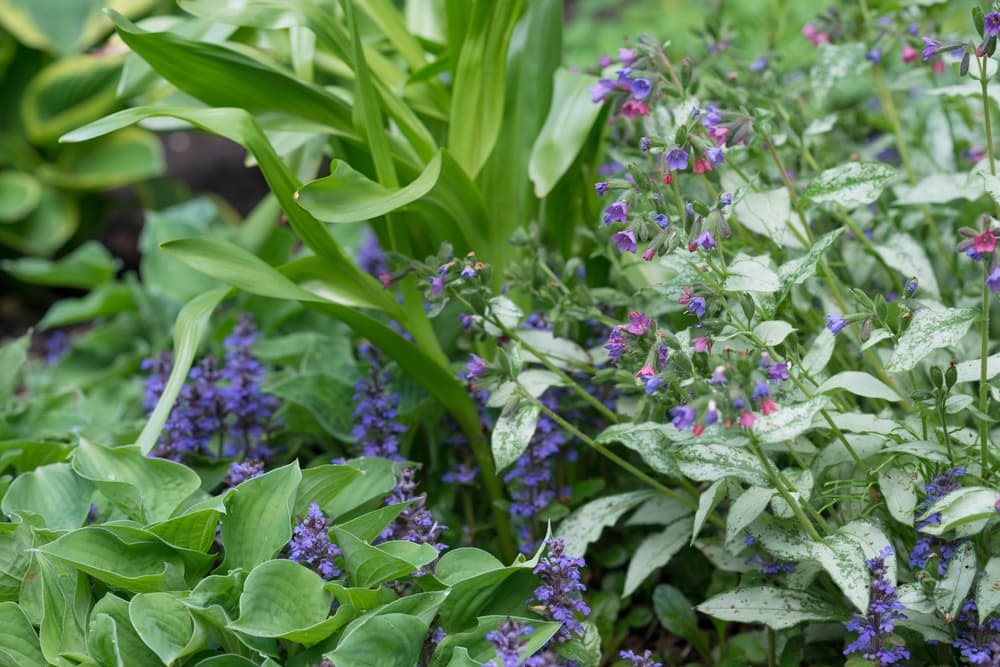
- BOTANICAL NAME: Pulmonaria officinalis
- HARDINESS RATING: H6
- PLANT TYPE: perennial
- FLOWERS: blue and pink
- FLOWERING SEASON(S): spring
- SOIL PREFERENCE: chalk, clay, loam; any pH
- SIZE: 0.1-0.5m in height, 0.1-0.5m spread
With green leaves that are spotted with white splashes, Common Lungwort already makes for an interesting pairing with hostas.
It is one of the companion plants for hostas recommended by Barry Ankney from the American Hosta Society, and it’s easy to see why.
Not only does this shade-loving perennial provide interesting foliage, but it produces bell-shaped pink flowers that change to a blueish hue with pink-veined petals later in the spring.
17) Asarabacca

- BOTANICAL NAME: Asarum europaeum
- HARDINESS RATING: H6
- PLANT TYPE: perennial
- FLOWERS: green and purple
- FLOWERING SEASON(S): spring
- SOIL PREFERENCE: clay, loam, sand; acidic to neutral pH
- SIZE: 0-0.1m in height, 0.1-0.5m spread
Asarabacca is another perennial on this list that is commonly grown primarily for its lovely foliage.
In the image above, you’ll notice it tucked away in the bottom right-hand corner, sharing the border with Plantain Lilies, ferns, Meconopsis, Yarrow and more.
With dark green, glossy leaves that are shaped like kidneys, this evergreen plant loves the shade and looks great in a leafy display with hostas and other ground cover plants.
This plant prefers acidic soil and will not survive in growing conditions with an alkaline pH.
18) Coral Bells

- BOTANICAL NAME: Heuchera sanguinea
- HARDINESS RATING: H6
- PLANT TYPE: perennial
- FLOWERS: red
- FLOWERING SEASON(S): summer
- SOIL PREFERENCE: loam and sand; neutral pH
- SIZE: 0.1-0.5m in height, 0.1-0.5m spread
Coral Bells, a garden favourite, produces beautiful tiny pink-red flowers that grow on woody stems in the summer months.
John Plant from Rewela Hostas, Barry Ankney from The American Hosta Society and Ollie Walker from Sienna Hostas all agree that heucheras are one of the best companion plants for hostas.
Growing well in partial shade, this perennial will inject some colour into your Plantain Lily displays and will grow best in loamy or sandy soil that has a neutral pH.
19) Sweet Woodruff

- BOTANICAL NAME: Galium odoratum
- HARDINESS RATING: H7
- PLANT TYPE: herb / perennial
- FLOWERS: white
- FLOWERING SEASON(S): spring
- SOIL PREFERENCE: all soil types; any pH
- SIZE: 0.1-0.5m in height, 1-1.5m spread
With small star-shaped flowers that grow in clusters on thin stems that reach up to 50cm tall, sweet woodruff is a lovely plant that provides a subtle touch of white to your hosta flowerbeds.
The leaves of this perennial herb are long and thin and produce a fresh aroma when in season.
20) Wild Daffodil
- BOTANICAL NAME: Narcissus pseudonarcissus
- HARDINESS RATING: H6
- PLANT TYPE: bulb / perennial
- FLOWERS: yellow
- FLOWERING SEASON(S): spring
- SOIL PREFERENCE: all soil types; any pH
- SIZE: 0.1-0.5m in height, 0-0.1m spread
What’s not to love about daffodils?
The bright yellow blooms of Narcissus pseudonarcissus can provide some much-needed early springtime colour when planted amongst Plantain Lily.
Not only are these popular bulbs easy to grow, but they also can be grown in many conditions and will cope well in partial shade.
21) Foam Flower

- BOTANICAL NAME: Tiarella cordifolia
- HARDINESS RATING: H5
- PLANT TYPE: perennial
- FLOWERS: cream
- FLOWERING SEASON(S): summer
- SOIL PREFERENCE: chalk, clay, loam; any pH
- SIZE: 0.1-0.5m in height, 0.1-0.5m spread
Tiarella cordifolia, also known as the ‘Foam Flower’, is a shade-loving perennial that produces small, fuzzy creamy-white flowers that grow at the top of stems that reach around 50cm in height.
Flowering in the summer, the Foam Flower bears green star-shaped leaves that are often tinged in bronze in the autumn months, adding more interest when grown next to other big-foliage plants.
Barry from the American Hosta Society cites tiarellas as one of the best companions for hostas.
22) Wood Anemone
- BOTANICAL NAME: anemone nemorosa
- HARDINESS RATING: H5
- PLANT TYPE: bulb / perennial
- FLOWERS: pink and white
- FLOWERING SEASON(S): spring
- SOIL PREFERENCE: clay, chalk, loam; any pH
- SIZE: 0.1-0.5m in height, 0.1-0.5m spread
I love wood anemones, as their sweet white flowers with yellowy centres are often tinged with pink – producing a delicate display that looks great in many garden planting schemes.
This bulbous perennial is only small, but it can add some colour to your garden beds and also grows well in shaded conditions.
23) Chinese Astilbe

- BOTANICAL NAME: Astilbe chinensis
- HARDINESS RATING: H7
- PLANT TYPE: perennial
- FLOWERS: pink
- FLOWERING SEASON(S): summer
- SOIL PREFERENCE: clay and loam; any pH
- SIZE: 0.5-1m in height, 0.5-1m spread
Chinese astilbe is great if you want to add some height alongside your Plantain Lilies.
With creamy-pink clusters of flowers growing from erect stems up to 1m tall in summer, these ‘goat’s beard’ blooms will surely stand out when planted with hostas and other smaller shrubs.
24) Japanese Forest Grass
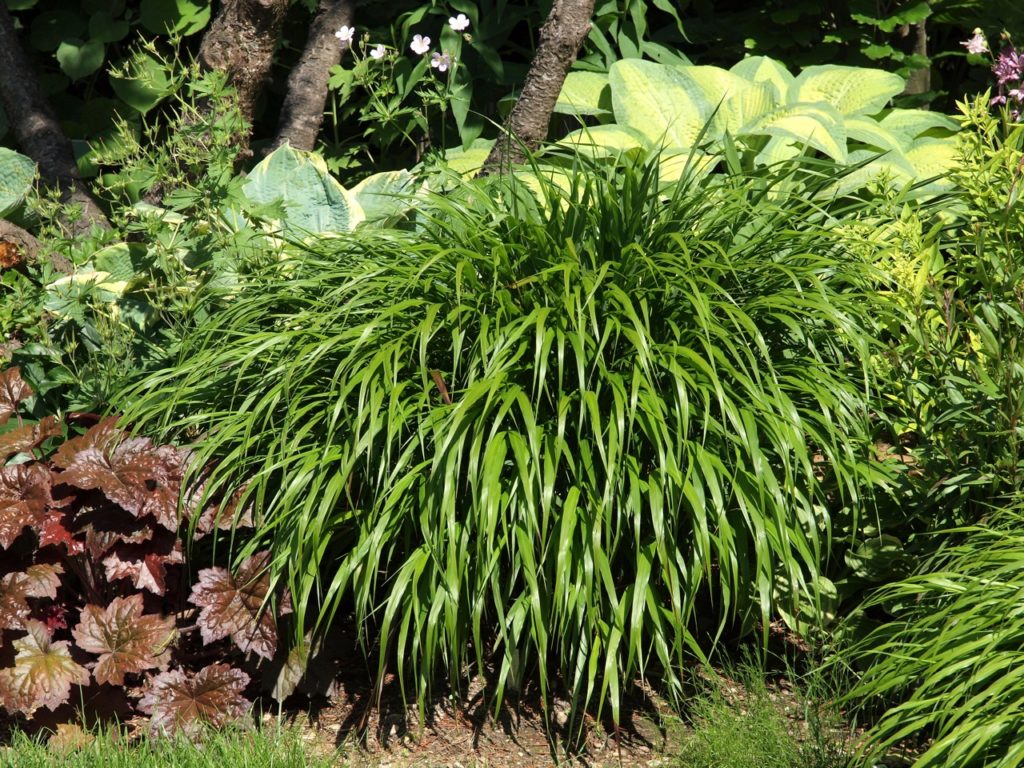
- BOTANICAL NAME: Hakonechloa macra
- HARDINESS RATING: H7
- PLANT TYPE: perennial / grass
- FLOWERS: green
- FLOWERING SEASON(S): summer
- SOIL PREFERENCE: all soil types; any pH
- SIZE: 0.1-0.5m in height, 0.1-0.5m spread
This glass-like shrub produces lots of long, drooping leaves that hang in layers, with green flowers emerging around the top of the plant in summer.
Japanese Forest Grass, as pictured above, works well with hostas, as its thin, grassy foliage provides a stark contrast to the large lobed leaves that hostas usually produce.
This shrub is relatively low-maintenance when planted out, so is a great choice for a garden scheme that won’t need tending too often.
25) Common Snowdrop
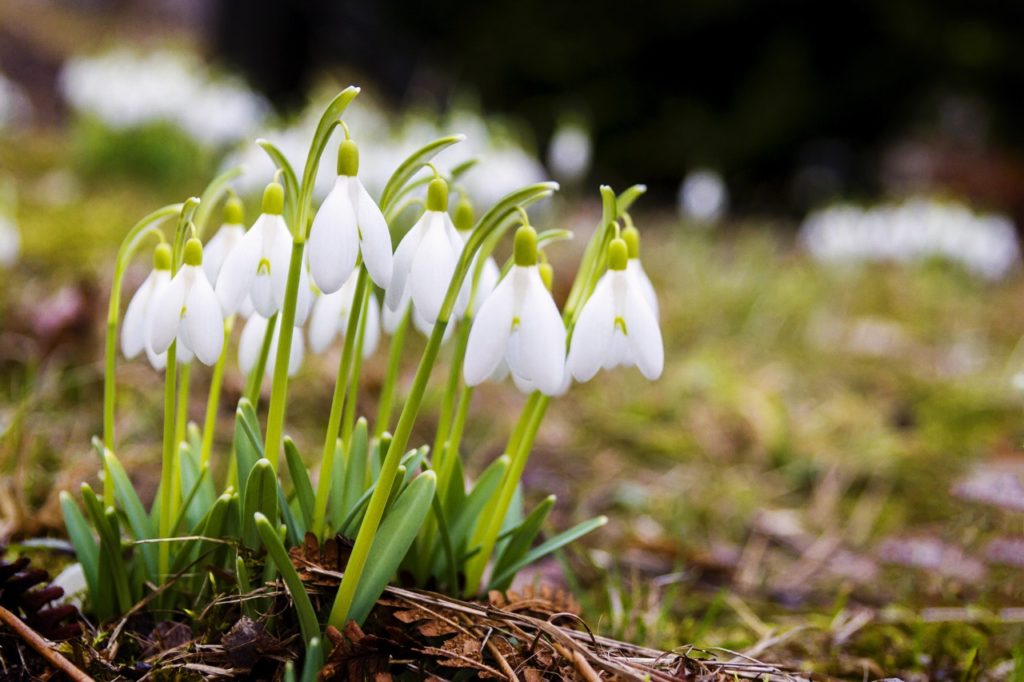
- BOTANICAL NAME: Galanthus nivalis
- HARDINESS RATING: H5
- PLANT TYPE: bulb / perennial
- FLOWERS: green and white
- FLOWERING SEASON(S): winter
- SOIL PREFERENCE: all soil types; any pH
- SIZE: 0.1-0.5m in height, 0-0.1m spread
Growing best in partial shade, the common snowdrop is a tiny contrast to the big leafy shrub of the Japanese Forest Grass.
This perennial bulb produces gorgeous drooping flowers in the winter months that can help liven up your displays whilst your Plantain Lilies are dormant.
Their leaves are often silvery, adding some festive colour during the cooler months.
“I cut back Helleborus x hyrbidus foliage in late winter and then mulch around it with compost to highlight its flowers against the dark soil,” shares Master Horticulturist Colin Skelly.
“Snowdrops make a great foil, coming through the mulch alongside yellow Eranthis hyemalis, Winter Aconite.”
26) Sikkim Spurge
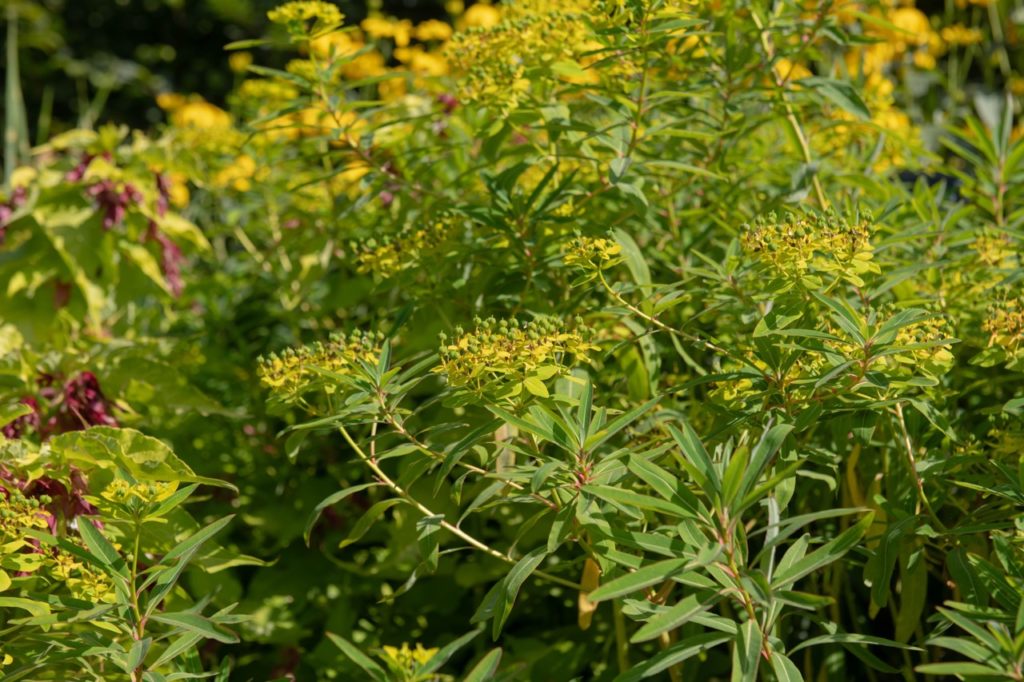
- BOTANICAL NAME: Euphorbia sikkimensis
- HARDINESS RATING: H5
- PLANT TYPE: perennial
- FLOWERS: yellow
- FLOWERING SEASON(S): summer
- SOIL PREFERENCE: all soil types; any pH
- SIZE: 1-1.5m in height, 0.1-0.5m spread
Sikkim spurge produces clusters of small yellow flowers during the summer and thin, long green and pink leaves throughout the year.
It can grow in sun or partial shade so is suitable for pairing with hostas if you’re looking for a burst of colour in the summer months.
27) Holly-Leaved Sweet Spire
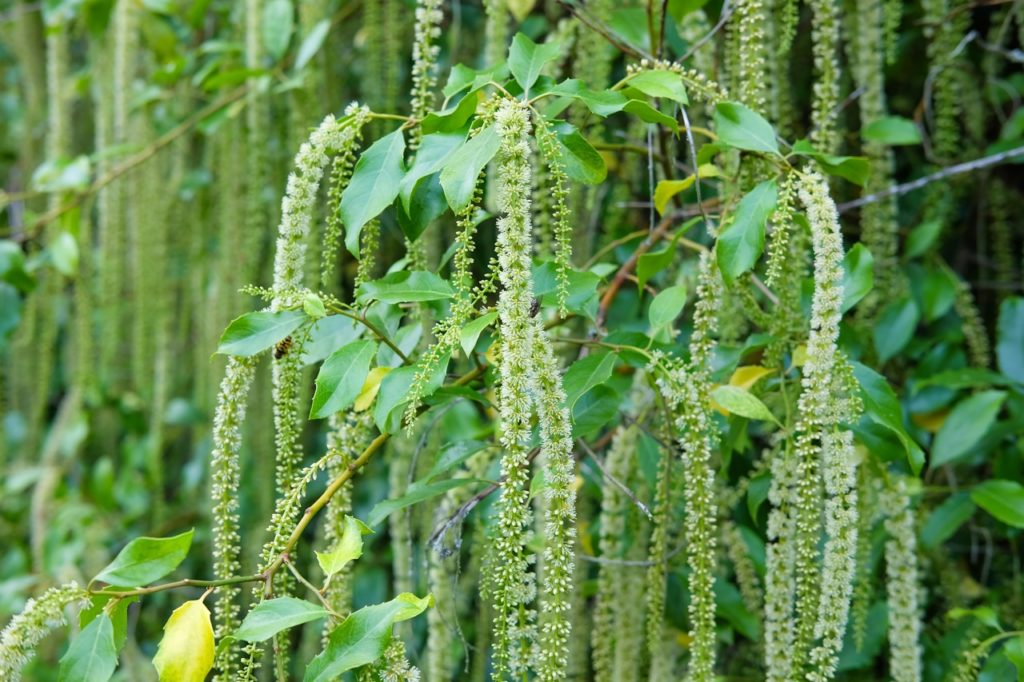
- BOTANICAL NAME: Itea ilicifolia
- HARDINESS RATING: H5
- PLANT TYPE: shrub
- FLOWERS: green and white
- FLOWERING SEASON(S): summer / autumn
- SOIL PREFERENCE: all soil types; any pH
- SIZE: 2.5-4m in height, 1.5-2.5m spread
Probably my favourite on this list, Itea ilicifolia, also known as the ‘Holly-Leaved Sweet Spire’, is an evergreen shrub that bears green and white tiny flowers on racemes that smell delightful.
These honey-scented blooms cascade between the glossy green leaves and are great for attracting pollinators to your garden.
When companion planting with hostas, I would place this stunning shrub behind to provide some shade and shelter, but so as to not let the Holly-Leaved Sweet Spire steal all of the glory.
28) Cohosh Bugbane
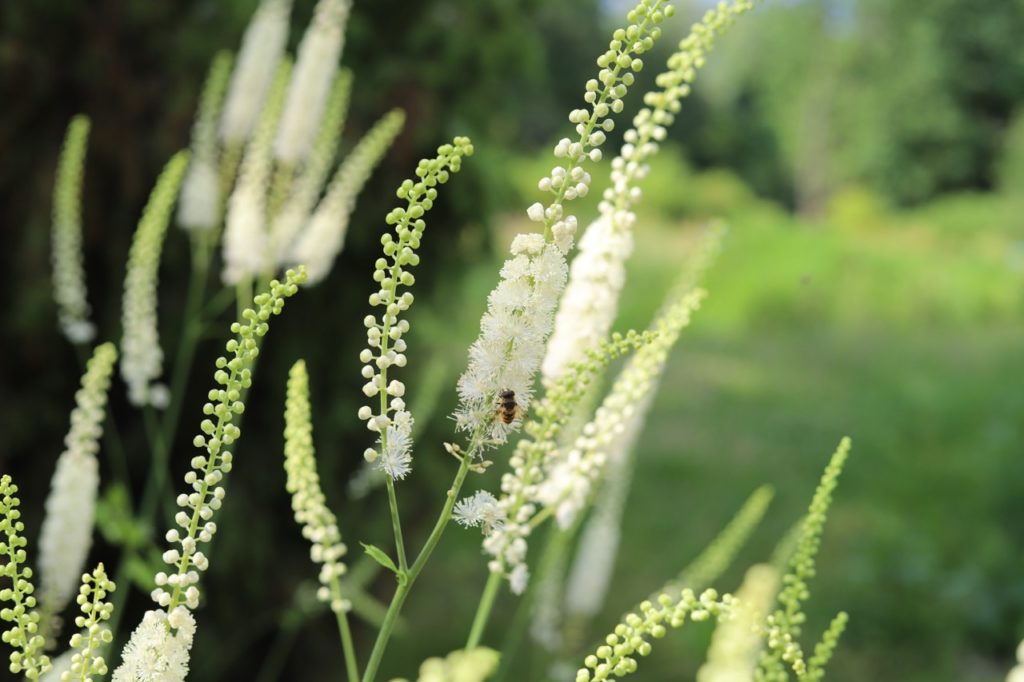
- BOTANICAL NAME: Actaea racemosa
- HARDINESS RATING: H7
- PLANT TYPE: perennial
- FLOWERS: white
- FLOWERING SEASON(S): summer
- SOIL PREFERENCE: clay or loam; any pH
- SIZE: 1-1.5m in height, 0.1-0.5m spread
With arching stems that reach up to 1.5m in height that bear white flowers, Cohosh Bugbane is another green choice for bees and other pollinators.
Growing best in partial shade, this summer-flowering perennial will add some fresh colour to your plant displays in the brighter months of the year.
29) Siberian Squill
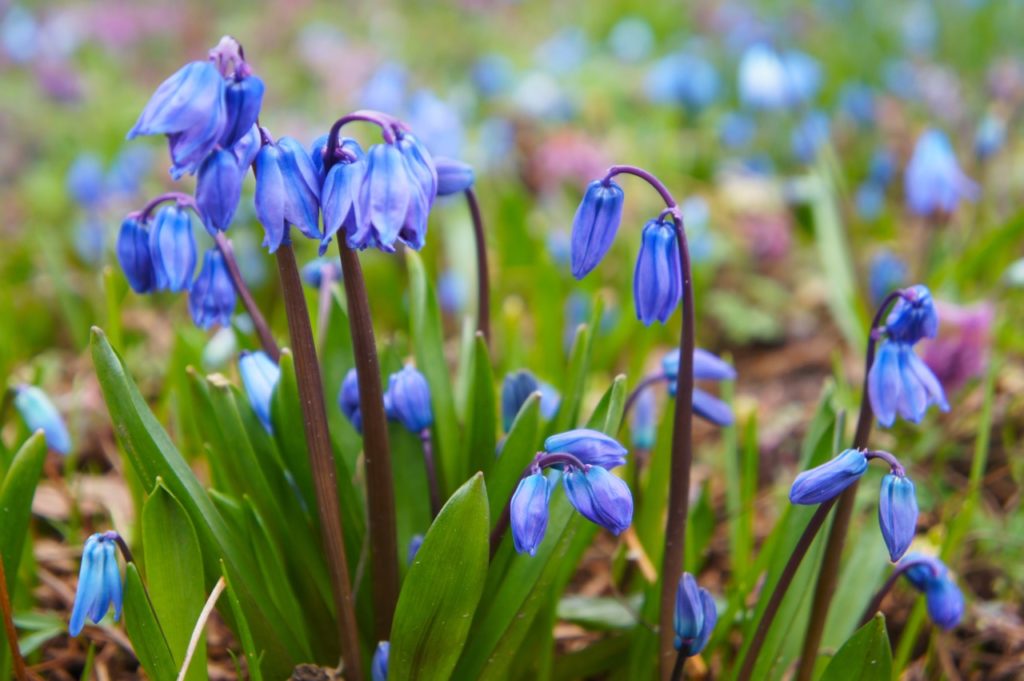
- BOTANICAL NAME: Scilla siberica
- HARDINESS RATING: H6
- PLANT TYPE: perennial / bulb
- FLOWERS: blue
- FLOWERING SEASON(S): spring
- SOIL PREFERENCE: chalk, loam, sand; any pH
- SIZE: 0.1-0.5m in height, 0-0.1m spread
Scilla siberica, or the ‘Siberian Squill’, is a small perennial with red drooping stems that bear blue bell-shaped flowers in the spring.
This is a great choice for some added colour in the early months of the year, but these plants will die back quickly, so if it’s longevity you’re after, this might not be the plant for you and your Plantain Lilies.
30) Painted Lady Fern
- BOTANICAL NAME: Athyrium niponicum var. pictum
- HARDINESS RATING: H5
- PLANT TYPE: fern
- SOIL PREFERENCE: clay, loam, sand; acidic to neutral pH
- SIZE: 0.1-0.5m in height, 0.1-0.5m spread
As I started this list with a fern, I felt it was only right to end with one too.
The painted lady fern has silvery-purple, lance-shaped leaves that would pair well with any hosta, particularly those that also are tinged with a pink or purple hue.
This fern loves acidic soil and can only cope with a position that is sheltered and in full to partial shade.

